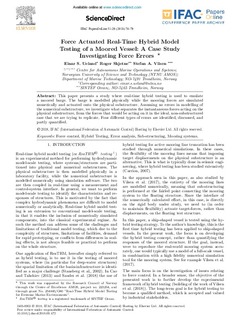| dc.contributor.author | Ueland, Einar Skiftestad | |
| dc.contributor.author | Skjetne, Roger | |
| dc.contributor.author | Vilsen, Stefan Arenfeldt | |
| dc.date.accessioned | 2019-01-30T12:24:39Z | |
| dc.date.available | 2019-01-30T12:24:39Z | |
| dc.date.created | 2018-10-28T14:21:29Z | |
| dc.date.issued | 2018 | |
| dc.identifier.citation | IFAC-PapersOnLine. 2018, 51 (29), 74-79. | nb_NO |
| dc.identifier.issn | 2405-8963 | |
| dc.identifier.uri | http://hdl.handle.net/11250/2583103 | |
| dc.description.abstract | This paper presents a study where real-time hybrid testing is used to emulate a moored barge. The barge is modelled physically while the mooring forces are simulated numerically and actuated onto the physical substructure. Assuming no errors in modelling of the numerical substructure, we investigate what separates the instantaneous forces acting on the physical substructure, from the forces that would be acting on it in the ideal, non-substructured case that we are trying to replicate. Four different types of errors are identified, discussed, and partly quantified. | nb_NO |
| dc.language.iso | eng | nb_NO |
| dc.publisher | International Federation of Automatic Control (IFAC) | nb_NO |
| dc.title | Force actuated real-tme hybrid model testing of a moored vessel: A case study investigating force errors | nb_NO |
| dc.title.alternative | Force actuated real-tme hybrid model testing of a moored vessel: A case study investigating force errors | nb_NO |
| dc.type | Journal article | nb_NO |
| dc.type | Peer reviewed | nb_NO |
| dc.description.version | publishedVersion | nb_NO |
| dc.source.pagenumber | 74-79 | nb_NO |
| dc.source.volume | 51 | nb_NO |
| dc.source.journal | IFAC-PapersOnLine | nb_NO |
| dc.source.issue | 29 | nb_NO |
| dc.identifier.doi | 10.1016/j.ifacol.2018.09.472 | |
| dc.identifier.cristin | 1624216 | |
| dc.description.localcode | © 2018, IFAC (International Federation of Automatic Control) Hosting by Elsevier Ltd. | nb_NO |
| cristin.unitcode | 194,64,20,0 | |
| cristin.unitname | Institutt for marin teknikk | |
| cristin.ispublished | true | |
| cristin.fulltext | postprint | |
| cristin.qualitycode | 1 | |
